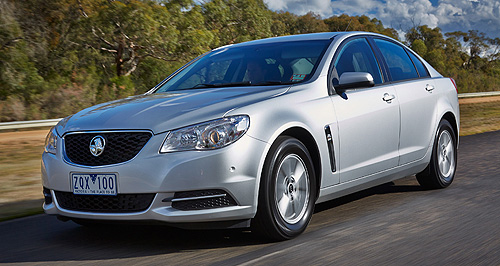News - HoldenGreen laws hint at early death for CommodoreFeeling green: Tougher emissions laws could halt production of the Commodore much earlier than Holden’s timeline for pulling out of manufacturing in Australia would suggest. Tighter emissions standards could spell an early end to Commodore production17 Dec 2013 By BARRY PARK HOLDEN’S last locally made Commodore could die earlier than expected thanks to emissions laws due to kick in long before the car-maker exits Australia. Holden has committed to keep making vehicles in Australia until late in 2017, with the car-maker switching to full importer status in 2018 as its US parent, General Motors, pulls out of unviable businesses worldwide. However, Euro 5 emissions standards that will apply to all new cars sold here are due to be introduced to Australia in November 2016 – and are likely to render the V6 engines that power Holden’s Commodore passenger car and ute range too dirty to sell here. Ford, which plans to end local production of the Falcon large car and Territory soft-roader in late 2016, will quit shortly before the Euro 5 standard is adopted for all new cars sold in Australia. Holden’s exit from manufacturing in Australia coincides with the introduction of even stricter Euro 6 emissions standards from July 2017 that will only apply to all-new models introduced to the market. Rather than confirming that the Commodore would stay in production to the end of 2017, Holden national manager of product communications Kate Lonsdale said because Euro 5 was a legal requirement, it was part of the car-maker's plans. Changing emissions standards have caught out Australian car-makers before. In 2010, Ford dropped the Territory Turbo, which used a turbocharged version of the locally made in-line 4.0-litre six-cylinder engine, from its showroom because it failed to meet the newly introduced Euro 4 emissions benchmark. Australian car-makers have always struggled to keep up with foreign rivals that have to develop low-emission vehicles, mainly for the European market. In 2010 as part of a submission to a discussion paper exploring the timing and impact of tougher emissions regulations in Australia, Holden pleaded with the federal government to set a carbon dioxide emissions target for 2015 at 199 grams per kilometre – only 9g/km lower than the 2012 industry-wide emissions average of all new cars sold in 2012. The National Transport Commission report into the average fuel economy across all new cars sold also showed the average across all Australian-made vehicles – including Toyota’s frugal Camry Hybrid that emits only 121g/km – was 210g/km. In the past, Ford has attempted to green up its act, spending $232 million in 2009 to fit a 2.7-litre turbo-diesel V6 engine under the bonnet of the Territory, producing a liquid injection system for its LPG-fuelled 4.0-litre six-cylinder engine, and fitting a turbocharged 2.0-litre petrol engine under the bonnet of the Falcon sedan. The car-maker last year also announced an extra $103 million will be spent on fuel-saving measures for facelifted versions of the Falcon and territory due mid-way through next year. Holden, meanwhile, has evolved its locally made 3.0-litre and 3.6-litre V6 engines to run on E85, a blend of petrol and ethanol that is meant to reduce Commodore owners’ dependence on petrol. In 2010, Holden had talked up a partnership with US ethanol producer Coskata, which said it planned to build a rubbish-to-ethanol plant in Victoria to produce up to 200 million litres of the fuel a year from household waste. Coskata has since announced it would halt ethanol production in favour of gas to liquid fuel production, which it says is potentially more lucrative. The demise of the Commodore also leaves a question mark over the roll-out of E85 ethanol-blended fuel in Australia. Late last year, Caltex Australia, which sells E85 at several sites in Adelaide, Melbourne Sydney and Brisbane, said the fuel was still a niche player, with motorists’ uptake of it “slower than anticipated”. Other than the Commodore range, four-cylinder petrol-engined versions of Holden’s Captiva mid-size soft-roader are the only other Lion-badged product to include the ability to run on E85. Caltex Australia senior media adviser Sam Collyer said despite flat sales of the fuel, E85’s launch three years ago was still regarded as a “positive move” by the company. “There was significant effort in the development and approval of the product as it was new to Caltex and the industry,” Mr Collyer said. “Additionally, marketing the product and educating customers about its benefits was also a significant effort. “We were certainly hopeful of an uplift in sales over the period as more flex fuel capable vehicles were in the market. However, sales of the product have been fairly flat for the past 12 months,” he said. Mr Collyer said Holden had not really promoted the Commodore’s flex-fuel capability “as strongly as what may have been needed” to drive higher sales of E85. “There are challenging economics involved in providing a product with such a small customer base and, as a result, the product has never reached an economic scale,” he said. “While there are currently no other flex-fuel partnerships we are a part of, we are always open to discussions with vehicle manufacturers looking to introduce flex-fuel vehicles into the Australian market. “We will continue to trial new products and gauge customer interest.”  Read more14th of June 2011  Holden seeks US rules for flex-fuel testCanberra to talk on emissions test rules that threaten to leave E85 out in the cold14th of June 2011  Ford buys time on engine deadlinePhased Euro 5 emissions introduction points to 2016 crunch date for Ford I6 |
Click to shareHolden articlesResearch Holden Motor industry news |
















Facebook Twitter Instagram